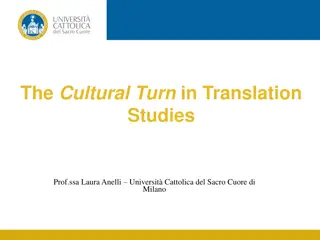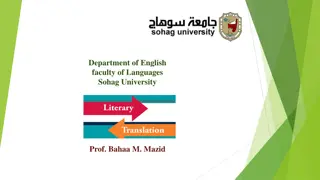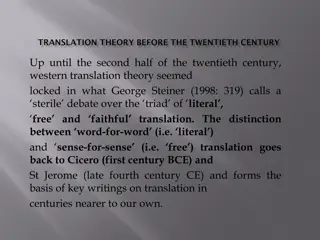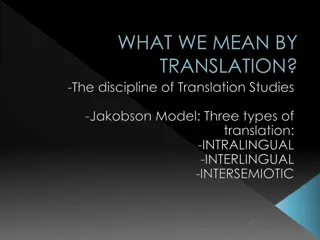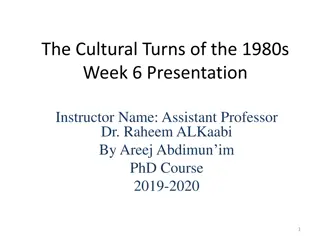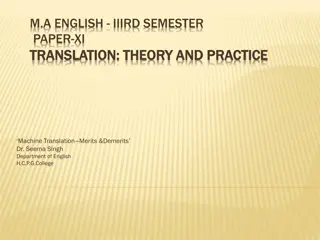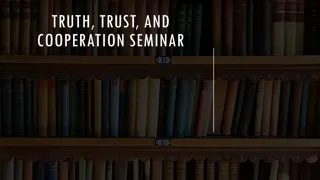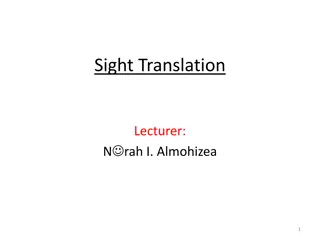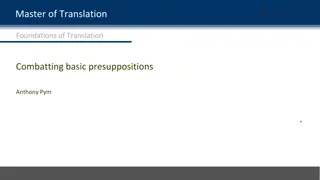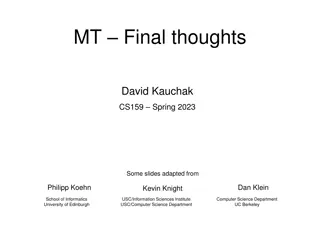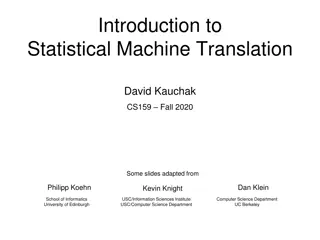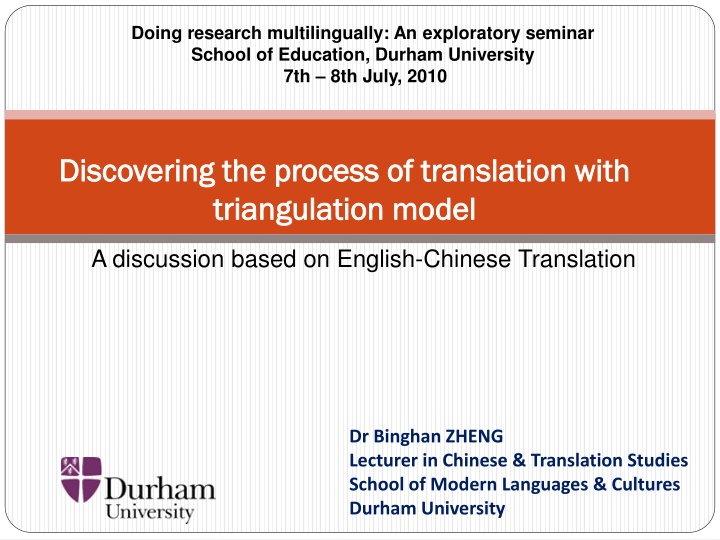
Exploratory Seminar on Translation Processes with Triangulation Model
Delve into the concept of translation problems and strategies through an exploratory seminar hosted by Dr. Binghan ZHENG at Durham University. Learn about the identification of translation problems and various indicators used in multilingual research methods.
Download Presentation

Please find below an Image/Link to download the presentation.
The content on the website is provided AS IS for your information and personal use only. It may not be sold, licensed, or shared on other websites without obtaining consent from the author. If you encounter any issues during the download, it is possible that the publisher has removed the file from their server.
You are allowed to download the files provided on this website for personal or commercial use, subject to the condition that they are used lawfully. All files are the property of their respective owners.
The content on the website is provided AS IS for your information and personal use only. It may not be sold, licensed, or shared on other websites without obtaining consent from the author.
E N D
Presentation Transcript
Doing research multilingually: An exploratory seminar School of Education, Durham University 7th 8th July, 2010 Discovering the process of translation with Discovering the process of translation with triangulation model triangulation model A discussion based on English-Chinese Translation Dr Binghan ZHENG Lecturer in Chinese & Translation Studies School of Modern Languages & Cultures Durham University
Outline Outline 1. Introduction & background 2. Previous research & findings 3. Methodology & research design 4. Analysis & discussion 5. Limitations & future research 6. Appendix Doing research multilingually_Durham_2010 BINGHAN ZHENG(DR) 2
1. Introduction and background The studies on translation problems (TPs) Concept of translation problems which manifests itself empirically has hardly been paid any attention by translation theorists. The reason for this may be the fact that translation theory has had a strong theoretical, speculative, and thus non- empirical orientation.(L rscher 1991:92) Since the1980s, with the emergence and development of a process-oriented approach into TS, the concept of translation problems and translation strategies has gained crucial importance. Doing research multilingually_Durham_2010 BINGHAN ZHENG(DR) 3
1. Introduction and background Krings (1986a:112-171) distinguishes between three types of problems occurring in translating: Translation problems L2-competence problems Translation-competence problems L rscher (1991:94) defines TPs as all those (linguistic) problems which a subject is faced with when producing a translation. Doing research multilingually_Durham_2010 BINGHAN ZHENG(DR) 4
1. Introduction and background How to identifying problems ?(Mondahl & Jensen 1996:102) Primary indicator: A translator s identification of the problem, i.e. points out the problem directly/indirectly & verbalizes about it. Secondary indicators: The translator senses that something is problematic, e.g. competes suggestions for translation of same ST element, underlines elements of ST, dissatisfies with the translation chosen, makes corrections, or pauses. Doing research multilingually_Durham_2010 BINGHAN ZHENG(DR) 5
1. Introduction and background Identifying TPs from TAPs in present research: 1) the translator points out the problem directly/indirectly & verbalizes about it; 2) the translator makes competing suggestions for the translation of the same ST element; 3) the translator indicates his/her pondering on some problem followed by long time pause. Doing research multilingually_Durham_2010 BINGHAN ZHENG(DR) 6
2. Previous research and findings 2.1 The number of TPs According to Ericsson & Simon (1984:90), with increasing experience of a task, a cognitively controlled process may change into an automatic process, so that what is available for verbalization to the novice may be unavailable to the expert. Krings (1986) compared the TAPs of 1 professional translator and 8 English students and found out that the professional reported more TPs. Doing research multilingually_Durham_2010 BINGHAN ZHENG(DR) 7
2. Previous research and findings 2.1 The number of TPs J skel inen & Tirkkonen-Condit (1991) further divided translation into routine & non-routine tasks. in non-routine tasks the total amount of verbalizations produced may not necessarily be considerably smaller, because while some processes become automated, other processes are evoked into consciousness, i.e., the translator becomes sensitized to new kinds of potential problems . Doing research multilingually_Durham_2010 BINGHAN ZHENG(DR) 8
2. Previous research and findings 2.2 The Hierarchy of TPs The hierarchy of translation problem translation strategy a translation strategy is a potentially conscious procedure for the solution of a problem which an individual is faced with when translating a text segment from one language into another (L rscher 1991a:76) Translation strategies The hierarchy of Translation Problems J skel inen (1993): Global strategies Global problems Local strategies Local problems BINGHAN ZHENG(DR) Doing research multilingually_Durham_2010 9
2. Previous research and findings 2.2 The Hierarchy of TPs S guinot (1991): text level problems lexical level problems Other arguments: non-professionals pay more attention to micro level translation problems (lexical choice, grammar reconstruction, etc.), professionals work more on macro level translation problems (style & function, cultural references, etc.) Gerloff 1988; Fraser 1993 Doing research multilingually_Durham_2010 BINGHAN ZHENG(DR) 10
2. Previous research and findings 2.2 The Hierarchy of TPs Deficiencies in previous research: 1. Short of precise and systematic classification of hierarchy of TPs 2. Insufficient in comparative studies on hierarchy of TPs 3. Small sample size and number of subjects Doing research multilingually_Durham_2010 BINGHAN ZHENG(DR) 11
2. Previous research and findings 2.2 The Hierarchy of TPs Hierarchy of TPs in present study: based on A Glossary of English Grammar (Leech 2006) and Problems in Analyzing Chinese Grammar (L Shuxiang 1979:28) The Hierarchy of TPs Hierarchy of Dynamic Unit (syntax knowledge is frequently applied) Hierarchy of Static Unit (syntax knowledge is rarely applied) Sentence and above level Word level Phrase level Clause level Doing research multilingually_Durham_2010 BINGHAN ZHENG(DR) 12
3. Methodology and research design The Triangulation Model(cf. Alves 2003) : Several data collection methods for cross-examination of the results Up-to-date ideal research model in process-oriented TS The Triangulation Model in present study: Translation evaluations Interviews (retrospective TAPs) Questionnaires TAPs Doing research multilingually_Durham_2010 BINGHAN ZHENG(DR) 13
3. Methodology and research design The subjects: 20 volunteer subjects Chinese L1, English L2 Three categories: professional, semi-professional, novice 36 samples collected from 18 subjects after screening Doing research multilingually_Durham_2010 BINGHAN ZHENG(DR) 14
3. Methodology and research design Basic information on subjects (S1-S18) Type Subject Age Range Translation Experience Less than 2 years part-time translation experience; less than 30,000 Chinese words in E C translation; have never published translation work. Novice S1-S6 20-24 More than 3 years part-time translation experience; have never had full-time professional translation experience; 100,000-300,000 Chinese words in E C translation; have never published translation work. Semi- professional S7-S12 25-29 More than 3 years full-time professional translation experience; more than 500,000 Chinese words in E C translation; have had some translation works published. Professional S13-S18 25-44 Doing research multilingually_Durham_2010 BINGHAN ZHENG(DR) 15
3. Methodology and research design The source texts Text a popular science essay. Text a political speech text. Concerns: To include different writing styles To balance the difficulties for translation Doing research multilingually_Durham_2010 BINGHAN ZHENG(DR) 16
3. Methodology and research design Experiment procedure a. TA training 3 GRE logic questions, verbalizing anything that went through minds. Introspective remarks or explanations to be strictly avoided. Feedback given with suggestions for improvement. Help for familiarization with the experimental environment in a usability lab. Doing research multilingually_Durham_2010 BINGHAN ZHENG(DR) 17
3. Methodology and research design Experiment procedure b. Data collection Start with a warm-up exercise Translate two STs with a briefing and perform concurrent thinking aloud translations. Monitoring and taking notes through a glass partition reminder with a remote apparatus when a subject becomes too engrossed in the task and forgets to verbalize for over 5 seconds. A follow-up interview after translation tasks Doing research multilingually_Durham_2010 BINGHAN ZHENG(DR) 18
3. Methodology and research design Experiment procedure c. Transcription and evaluation Transcription conventions were based on Englund Dimotrova (2005) with some additional unique symbols. Two professors who are experienced in marking E-C translation tests to assess the target texts (TTs) produced by all subjects. Doing research multilingually_Durham_2010 BINGHAN ZHENG(DR) 19
4. Analysis and discussion 4.1. The number of TPs A. Data analysis: In general, the number of TPs decreases with the improvement in translation proficiency. Number & percentage (total) Number & percentage (routine) Number & percentage (non-routine) Type Novices Semi- professionals 208; 38.45% 109; 43.78% 99; 33.90% 175; 32.35% 76; 30.52% 99; 33.90% Professionals Doing research multilingually_Durham_2010 158; 29.20% 64; 25.70% 94; 32.20% BINGHAN ZHENG(DR) 20
4. Analysis and discussion 4.1. The number of TPs A. Data analysis: In line with the automaticity hypothesis: cognitive processes tend to become more automatic through repeated practice, hence professionals, with more practice and experience in translation, tend to have fewer translation problems. Number & percentage (total) Number & percentage (routine) Number & percentage (non-routine) Type Novices Semi- professionals 208; 38.45% 109; 43.78% 99; 33.90% 175; 32.35% 76; 30.52% 99; 33.90% Professionals Doing research multilingually_Durham_2010 158; 29.20% 64; 25.70% 94; 32.20% BINGHAN ZHENG(DR) 21
4. Analysis and discussion 4.1. The number of TPs A. Data analysis: Compare: A. Professional translator in Seguinot (1989) verbalised little and in general worked quickly and efficiently. --Carried out routine tasks B. Krings (1988a), Gerloff (1988), and J skel inen (1990b) reported the exact opposite happening: professional translators spent more time and more effort on the task than non-professionals. --Carried out non-routine tasks Doing research multilingually_Durham_2010 BINGHAN ZHENG(DR) 22
4. Analysis and discussion 4.1. The number of TPs B. Further study on routine and non-routine tasks: a) In routine tasks, the number decreases significantly at the higher levels of translation proficiency; while in non-routine tasks, there are almost no differences between three types of subjects in number of TPs. Number & percentage (total) Number & percentage (routine) Number & percentage (non- routine) Type Novices Semi- professionals 208; 38.45% 109; 43.78% 99; 33.90% 175; 32.35% 76; 30.52% 99; 33.90% Professionals Doing research multilingually_Durham_2010 158; 29.20% 64; 25.70% 94; 32.20% BINGHAN ZHENG(DR) 23
4. Analysis and discussion 4.1. The number of TPs B. Further study on routine and non-routine tasks: b) Novices have minimum difference between routine and non-routine tasks in number of TPs (109 vs 99), while professionals have maximum difference (64 vs 94). Number & percentage (total) Number & percentage (routine) Number & percentage (non- routine) Type Novices Semi- professionals 208; 38.45% 109; 43.78% 99; 33.90% 175; 32.35% 76; 30.52% 99; 33.90% Professionals Doing research multilingually_Durham_2010 158; 29.20% 64; 25.70% 94; 32.20% BINGHAN ZHENG(DR) 24
4. Analysis and discussion 4.1. The number of TPs B. Further study on routine and non-routine tasks: c) 14 out of 18 subjects (77.8%) have fewer TPs in carrying out routine tasks, which means routine tasks are performed quickly and effortlessly with fewer TPs to be solved; however, this rule does not apply to novices as only 50% of them have fewer TPs in doing routine tasks. Number & percentage (total) Number & percentage (routine) Number & percentage (non- routine) Type Novices Semi- professionals 208; 38.45% 109; 43.78% 99; 33.90% 175; 32.35% 76; 30.52% 99; 33.90% Professionals Doing research multilingually_Durham_2010 158; 29.20% 64; 25.70% 94; 32.20% BINGHAN ZHENG(DR) 25
4. Analysis and discussion 4.1. The number of TPs C. Conclusion: The number of TPs can by no means serve as an indicator for translation proficiency in a general way. It reduces with increased automaticity in translating, but increases with growing awareness of potential problems. This is the same for translators in non-routine situations. The number of TPs can to some extent serve as an indicator for translation proficiency in translating routine tasks. Doing research multilingually_Durham_2010 BINGHAN ZHENG(DR) 26
4. Analysis and discussion 4.2. The hierarchy of TPs A. General distribution of TPs in different hierarchies Static Unit(word, phrase level) accounts for 71.22%; Dynamic Unit(clause, sentence and above sentence level) accounts for 28.79%. Sentence and above level 6.31 8.02 13.62 Type Novices Word level 47.68 28.76 26.24 Phrase level 33.91 45.56 31.51 Clause level 12.10 17.67 28.62 Semi-professionals Professionals Average percentage 34.23 36.99 19.47 9.32 Doing research multilingually_Durham_2010 BINGHAN ZHENG(DR) 27
4. Analysis and discussion 4.2. The hierarchy of TPs A. General distribution of TPs in different hierarchies Compare: Krings (1987:169) argued that 90% of TPs are at word level, which is much higher percentage than that in our statistic result. Sentence and above level 6.31 8.02 13.62 Type Novices Word level 47.68 28.76 26.24 Phrase level 33.91 45.56 31.51 Clause level 12.10 17.67 28.62 Semi-professionals Professionals Average percentage 34.23 36.99 19.47 9.32 Doing research multilingually_Durham_2010 BINGHAN ZHENG(DR) 28
4. Analysis and discussion 4.2. The hierarchy of TPs A. General distribution of TPs in different hierarchies Justifications: a) Krings subjects are 8 English MA students, classified as non- professionals in our research, have comparatively higher percentages in lower level TPs. Krings translation tasks--English-German translations (between family languages) The present tasks--English-Chinese translations (between distant languages). Due to larger difference in syntax structures & cultural factors, E-C translation is comparatively more complicated, produces more macro TPs to be considered. Doing research multilingually_Durham_2010 b) BINGHAN ZHENG(DR) 29
4. Analysis and discussion 4.2. The hierarchy of TPs A. General distribution of TPs in different hierarchies Features in Chinese language: parataxis, covert cohesion, preponderance of verbs, (verb) serialization, etc. Features in English language: hypotaxis, overt cohesion, preponderance of nouns, subordination, etc. E-C translating, to faithfully render English into expressive and idiomatic Chinese expressions, avoiding Europeanized translation, a translator has to deal with many translation problems at clause, sentence and above sentence level. Doing research multilingually_Durham_2010 BINGHAN ZHENG(DR) 30
4. Analysis and discussion 4.2. The hierarchy of TPs B. Comparative study of TPs among different translators: Percentages in hierarchy of Static Unit: Professionals Semi-professionals Novices Percentages in hierarchy of Dynamic Unit: Novices Semi-professionals Professionals Sentence & above level 6.31 8.02 13.62 Type Novices Word level 47.68 28.76 26.24 Phrase level 33.91 45.56 31.51 Clause level 12.10 17.67 28.62 Semi-professionals Professionals Average percentage 34.23 36.99 19.47 9.32 31 BINGHAN ZHENG(DR) Doing research multilingually_Durham_2010
4. Analysis and discussion 4.2. The hierarchy of TPs B. Comparative study of TPs among different translators: In line with J skel inen(1993) & L rscher(1993): with improvement in translation proficiency, a translator tends to have more macro level TPs. Sentence & above level 6.31 8.02 13.62 Type Novices Word level 47.68 28.76 26.24 Phrase level 33.91 45.56 31.51 Clause level 12.10 17.67 28.62 Semi-professionals Professionals Average percentage 34.23 36.99 19.47 9.32 32 BINGHAN ZHENG(DR) Doing research multilingually_Durham_2010
4. Analysis and discussion 4.2. The hierarchy of TPs B. Comparative study of TPs between different translators: Justifications: a) More potential micro level problems (lexical choice, collocation, idiom equivalence) can be solved within automatic translation processes. b) Translators become more sensitive to macro level problems, more flexible in sentence transference and consider more translation problems inherent in language structures. In E-C translation, dividing English long sentences into Chinese short sentence expressions, changing English passive voice into Chinese active voice, are all favored strategies leading to better translation. Doing research multilingually_Durham_2010 BINGHAN ZHENG(DR) 33
4. Analysis and discussion 4.2. The hierarchy of TPs B. Comparative study of TPs between different translators: Justifications: c) Different modes of translation process: Professionals: top-down approach Focus: A global view and overall understanding of the text Novices: bottom-up approach Focus: The expression of separate words or phrases Doing research multilingually_Durham_2010 BINGHAN ZHENG(DR) 34
5. Limitations and future research Limitations: Experimental techniques & corpus scale Future research: Chinese into English translation Triangulation model consisting of TAPs, Translog or Camtasia, post-experiment interviews and so on. Doing research multilingually_Durham_2010 BINGHAN ZHENG(DR) 35
6. Appendix transcription and protocol presenting examples of TAPs Explanations and examples on consulting purposes (CP) Explanations CP TAPs examples S2/novice/V1 TAPs symphony s-y-m- p-h-o-n-y symphony symphony The participant is facing an unfamiliar word or phrase and consulting it with translation instruments. CM English for TAPs symphony Kingsoft Powerword Check the meaning s-y-m-p-h-o-n-y Jiaoxiangyue, Jiaoxiangqu, Jiaoxiangyue symphony symphony ok, use jiaoxiangqu. S7/semi-professional/V2 TAPs terror t-e-r-r-o-r 14s The participant is not sure about the meaning of a word or phrase and verifying it with translation instruments. VM English for TAPs terror, how about Kongbu Shili Have a check. Kingsoft Powerword t-e-r-r-o-r 14s eh, Women Gongtong Fandui Kongbu Xing Kongbu Xingdong
Explanations CP TAPs examples S14/professional/V1 TAPs judgment judgment ? judgment judgment conceive conceive ...... judgment The participant acknowledges the general meaning of a word or phrase and search for its extra optimized expressions to fit for the particular context. OE English for TAPs judgment, say, Pingpan?/Lunduan? eh look it up first, judgment, see if any other translations Kingsoft Powerword judgment judgment er Yijian, Kanfa, ok then I can translate it as Here s conceive . Conceive generally refers to a very important theory. Cannot only say Daode de Yige Kanfa Daode Pingpan Panduan ...... So judgment here can only be translated as Panduan. S13/professional/V1 TAPs brilliant brilliant brilliant brilliant l-i-a-n-t brilliant [2s] brilliant The participant acknowledges the meaning of a word or phrase and search for its proper collocation from translation instruments [2s] SC English for TAPs brilliant Weida de brilliant brilliant change a word, change a word, coz there are Weida and Jiechu already, should use a synonym brilliant have a check in the Powerword Kingsoft Powerword l-i-a-n-t brilliant You Caiqi de [2s] Caiqi Caiqi modifies a person, not a theory [2s]think about a what theory scientific theory think about a brilliant Huihuang de Zhuangli de Chaoqun de Chaoqun de Zuoyue de, say, Zuoyue de or Chaoqun de scientific theory.
Doing research multilingually: An exploratory seminar School of Education, Durham University 7th 8th July, 2010 Thank you very much! Thank you very much! Questions & Questions & comments comments Contact Information: Binghan ZHENG (Dr) Lecturer in Chinese & Translation Studies School of Modern Languages & Cultures Durham University Email: Binghan.zheng@durham.ac.uk 38



